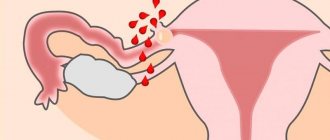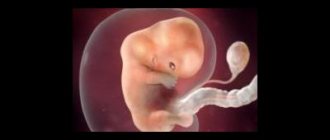How does a pregnancy test work?
It is clear that a weak line on a pregnancy test can only appear on a device that expects to produce results in the form of stripes. Therefore, further we will talk about strip tests. These devices are in high demand among women due to their affordable price but fairly high accuracy.
All pregnancy test strips work on the same principle. They are equipped with an indicator that indicates whether the woman is in position or not. This band detects human chorionic gonadotropin and appears if this hormone is present in the woman’s urine in the required volume. It is intensively produced by the body after the embryo enters the uterine cavity and is implanted to its wall. After this, the hCG level begins to double every day. Using ultra-sensitive tests, pregnancy can be detected as early as 7-10 days after conception.
If there is no hormone in a woman’s urine or there is too little of it, then one line appears on the test. When the hCG level reaches 10-25 mIU/ml (depending on the sensitivity of the device), a second line appears on the test, which indicates pregnancy. However, sometimes it can be barely noticeable, which happens for a number of reasons.
Types of express tests
- test strip (strip test) - the most affordable;
- jet test (midstream test) - the most convenient to use;
- tablet (or cassette) test is the most accurate;
- The digital electronic test is the most high-tech, involves multiple use and allows you to detect not only the presence of pregnancy, but also its exact duration (up to 3 weeks).
All these types of tests provide the highest percentage of reliability. To minimize the risk of error, you should use test systems from trusted manufacturers.
The gradation of rapid tests for determining pregnancy depends on the sensitivity of the reagent used. Highly sensitive tests (from 10 mIU/l) - allow you to detect pregnancy even before a missed period. Tests with normal sensitivity (from 25 mIU/l) are used from the first days of a delayed menstrual cycle. The only drawback of high-quality test systems with the highest sensitivity is their relatively high cost.
Reasons for the appearance of a weak second line on the test
If the second line on the test is barely noticeable, then this may indicate either a false positive result (there is no pregnancy, but the test will detect it) or a false negative result (there is a pregnancy, but the test does not recognize it).
Possible reasons for incorrect operation of the device are as follows:
- A woman is pregnant, but she takes the test too early. In this case, the content of human chorionic gonadotropin in the urine does not reach the level necessary for the test to fully react.
- The test itself was of poor quality. A faint line may appear when the device is expired, defective, or improperly stored. A woman should be especially wary when both stripes are blurry or weak. Spots may appear on the test or a streak may form in the wrong place - all these are signs of damage to the device.
- The sensitivity of the test has a low threshold. The higher the sensitivity of the test to hCG, the more reliable the result. Modern devices are capable of detecting the hormone in urine, starting from 10 mIU/ml. The most “unreliable” in this regard are the inexpensive strip tests, which have a sensitivity of 25 mIU/ml and, in the early diagnosis of pregnancy, often give a questionable result.
- Too much or too little urine was tested. If the test is overexposed to urine, this may result in the reagent simply spreading across the strip and making it unclear. When a woman does not pass the urine test for the required time, this will cause the hCG hormone to be insufficient to completely color the second line.
- Unstable menstrual schedule. In the case when a woman’s monthly cycle is unsettled, she may conduct the study too early, which means that hCG in the urine will not be enough to obtain a clear result.
- Late onset of pregnancy. This reason is also associated with conducting the study too early. Sometimes it happens that ovulation is somewhat delayed. As a result, fertilization of the egg occurs not in the middle of the cycle, but closer to its end. Naturally, menstruation does not occur, but there is still not enough chorionic gonadotropin in the urine for the test to be able to “examine” it well.
- Recent abortion. If a woman had an abortion several weeks ago, human chorionic gonadotropin continues to circulate in her body. Gradually its level decreases, but a sharp decline cannot occur. Therefore, a test performed 4-30 days after an abortion will show a weak second line, although in fact there is no pregnancy.
- Taking medications with hCG. Some medications contain human chorionic gonadotropin, for example, tablets for the treatment of infertility (Pregnil, Profazi, Novarel and others). Even after completing the therapeutic course, their components may linger in the body for some time and lead to the appearance of a weak second line on the test.
- Trophoblastic diseases, for example, uterine chorionepithelioma, contribute to an increase in the level of hCG in the blood and urine, which can provoke the appearance of a pale line on the test, despite the absence of an embryo. Sometimes this result can be obtained with uterine fibroids, ovarian cysts or hydatidiform moles.
- Presence of an ectopic pregnancy. Often, it is during an ectopic pregnancy that the second line on the test appears weakly. The body produces human chorionic gonadotropin, but in insufficient quantities, so the device cannot give an adequate response.
- Frozen pregnancy. In this case, the woman’s embryo remains in the uterine cavity, but it has stopped developing. Accordingly, the rate of hormone production decreases, which can lead to the appearance of a faint line on the test. A woman should be alerted to such signs as pain in the lower abdomen, bleeding, lack of menstruation, and increased body temperature.
- Climax. Sometimes during menopause, due to hormonal imbalance, a woman’s level of human chorionic gonadotropin in the blood and urine increases. This may cause the test result to be inconclusive.
- Kidney diseases. If a woman has severe impairments in the functioning of her kidneys, this may lead to the fact that hCG in the urine will not be excreted in sufficient volumes. Therefore, the test in this case often reacts to the presence of pregnancy with a weak second stripe.
Test manufacturers note that the presence of a faint line on the test should be considered a positive result.
However, it is still recommended to carry out a follow-up study using a new pregnancy test. It is best to do this after a few days. If the second test produces a bright and clear band, then the result can be confidently considered positive. When the test line is weak or blurry again, you should consult a specialist. Indeed, often such test results can indicate health problems.
Additional Methods
In addition to rapid tests, there are other ways to diagnose pregnancy. A blood test for beta-hCG will help assess the correct course of pregnancy in the early stages. This type of analysis allows you to find the exact amount of the hormone in the patient’s blood and track the dynamics of its growth. A very slow increase in hCG indicates difficulties associated with the pathology of embryo development, and a very rapid increase indicates the likelihood of a multiple pregnancy. This is the most accurate way to determine pregnancy; it can be used to confirm the result of the test, which gives the highest, but still not one hundred percent, guarantee. And also, a blood test for beta-hCG will allow you to detect pregnancy at an extremely early stage, which is especially important when conceiving using IVF.
If the pregnancy test is positive, an urgent consultation with an obstetrician-gynecologist is required. Proper support of pregnancy from the first weeks is the key to the birth of a healthy baby. An express test is the fastest and most accurate method for diagnosing pregnancy in the early and very early stages. But if you do not want pregnancy, it is best to use modern methods of contraception.
How to get the most reliable result?
In order for the test results to be as reliable as possible, you must read the instructions for using the test and strictly follow them.
Following the simple rules of the procedure will help you avoid the appearance of a pale second line on the test and clearly interpret the result:
- It is best to carry out the testing procedure no earlier than the first day of missed menstruation. Some doctors even advise waiting at least 5-7 days from the expected start date of your period. The earlier pregnancy is diagnosed, the less chance that the result will be 100% reliable.
- To perform the test, you must take only fresh urine. It is good if it is possible to perform the procedure in the morning, immediately after waking up. It is at this time that the concentration of human chorionic gonadotropin in the urine will be maximum.
- If the procedure is planned for the evening, then during the day you need to avoid drinking too much liquid. Also, on the eve of the study, you should avoid taking diuretics and any other drugs that have a diuretic effect.
- The exposure time of urine to the test should not be less than 5-15 seconds (according to the instructions for use).
- Before carrying out the procedure, you need to take care of the cleanliness of the container for collecting urine and the external genitalia.
- The result should be assessed no earlier than after 3-5 minutes. Until this time, the second stripe (if it appears) may remain weak and dim.
What diseases can cause absence of menstruation?
Delayed menstruation is caused by the following gynecological diseases:
- polycystic ovary syndrome;
- ovarian wasting syndrome;
- inflammatory processes in the tissues of the uterus and appendages;
- corpus luteum cyst;
- fibroids and other types of tumors.
IMPORTANT! Do not try to diagnose yourself or prescribe any medications yourself. To make sure that the cause of the delay was any gynecological disease, it is necessary to undergo an examination by a doctor who, if necessary, will prescribe an adequate course of treatment.
Features of the test
When to test after embryo transfer
? As already mentioned, tests should be taken 14 days after the IVF procedure. Reproduction specialists identify several rules that must be taken into account before conducting the test:
- Only the first morning urine is used for testing;
- the test results are assessed after a few minutes;
- The test should be carried out at a temperature of 23-26 degrees;
- The test strip is placed in the urine for 5-7 seconds.
Decoding the results
After using cassette, inkjet and other express tests, the following results are obtained:
- negative – most often indicates the absence of pregnancy or fetal death;
- doubtful - signals late penetration of blastocysts into the endometrium, ectopic pregnancy or premature rapid test;
- positive – highly likely indicates successful IVF.
To get a reliable result, it is recommended to do a blood test at a fertility center. Laboratory techniques are more sensitive and also allow you to determine the content of hCG in the blood serum. Based on the results, one can judge the characteristics of the course of gestation, the likelihood of multiple or ectopic pregnancy.








